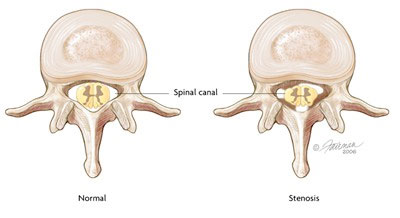Spinal Stenosis Treatment & Surgery
What is Stenosis?
Spinal stenosis is a narrowing of the open spaces within your spine, which can put pressure on your spinal cord and the nerves that travel through the spine. Spinal stenosis occurs most often in the neck and lower back. While some people have no signs or symptoms, spinal stenosis can cause pain, numbness, muscle weakness, and problems with bladder or bowel function. Spinal stenosis is most commonly caused by wear-and-tear changes in the spine related to aging. In severe cases of spinal stenosis, doctors may recommend surgery to create additional space for the spinal cord or nerves.Some people are born with a small spinal canal. This is called “congenital stenosis”. However, spinal narrowing is most often due to age-related changes that take place over time. This is called “acquired spinal stenosis.”

Spinal Stenosis can cause the following:
Sciatica – pain that radiates along the path of the sciatic nerve — which branches from your lower back through your hips and buttocks and down each leg. Typically, sciatica affects only one side of your body. There are many causes of sciatica.
Neurogenic intermittent claudication – Leg fatigue and/or weakness and leg numbness and/or paresthesia.
Pain
- Bilateral leg pain with burning or cramping. Involves buttocks and thighs and spreads to the feet.
- The neural canal and neural foramen are narrowed with the spine in backward extension and opened in forward flexion, neural compression is usually intermittent and provoked by lying prone or extending (arching) the lumbar spine, and when upright, particularly when walking.
- Cycling does not usually cause significant problems.
- The pain is usually relieved by sitting, leaning forward, putting the foot on a raised cushion or stool, or lying supine.
Cauda equina compression
- Caused by any narrowing of the spinal canal that compresses the nerve roots below the level of the spinal cord.
- May be due to trauma, disc herniation, spinal stenosis, spinal neoplasms, inflammatory or infectious conditions.
- Features of cauda equina compression include low back pain, unilateral or bilateral sciatica, saddle and perineal anaesthesia, bowel and bladder disturbances, and weakness, sensory deficits and reduced or absent reflexes in the legs.
